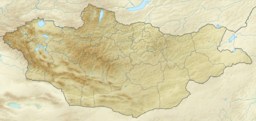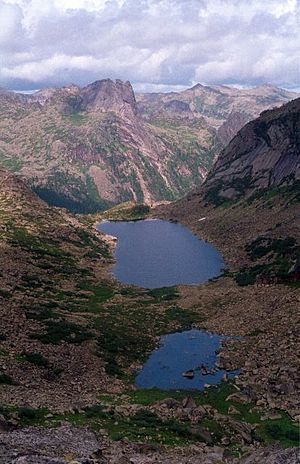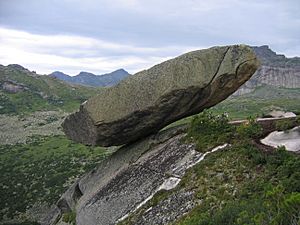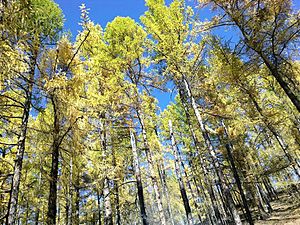Sayan Mountains facts for kids
Quick facts for kids Sayan Mountains |
|
|---|---|
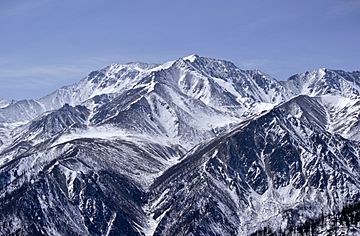
View of Mönkh Saridag, highest peak in the Sayan Mountains
|
|
| Highest point | |
| Peak | Mönkh Saridag |
| Elevation | 3,492 m (11,457 ft) |
| Geography | |
| Parent range | South Siberian Mountains |
The Sayan Mountains are a large mountain range in southern Siberia, Russia, and northern Mongolia. These mountains once marked the border between Mongolia and Russia. They are known for their tall peaks and cool lakes.
Many small rivers start in the Sayan Mountains. These rivers then join together to form the Yenisei River. The Yenisei is one of Siberia's most important rivers. It flows north for over 3,400 kilometers (2,000 miles) to the Arctic Ocean. The Sayan Mountains area was kept closed by the Soviet Union for a long time, making it a very protected and isolated place.
Contents
Exploring the Sayan Mountains
The Sayan Mountains are split into two main parts: the Western Sayan and the Eastern Sayan. Each part has its own unique features and landscapes.
Western Sayan: Rivers and Peaks
The Western Sayan mountains stretch for about 650 kilometers (400 miles). They run from the Altai Mountains in the west to the Kuznetsk Alatau in the east. The Yenisei River cuts through this part of the mountains.
If you are coming from the Mongolian plateau, the climb into the Western Sayan is gentle. But from the Siberian plains, it is much steeper. This area has many smaller mountain ranges. Some of the important peaks include Kyzlasov Peak (2,969 meters or 9,741 feet high) and Borus (2,318 meters or 7,605 feet high).
The plants here are not very diverse. However, higher up, you can find forests of larch, pine, juniper, birch, and alder trees. You might also see colorful rhododendrons. Many large rocks on the upper slopes are covered in lichens and mosses.
Eastern Sayan: Tallest Peaks and Waterfalls
The Eastern Sayan mountains are even longer, stretching for about 1,000 kilometers (620 miles). They run from the Yenisei River towards the Angara Range. Some parts of the Eastern Sayan are called "White Mountains" because their peaks are always covered in snow.
In the central part, you can find Grandiozny Peak. It is 2,982 meters (9,783 feet) high and is the tallest point in the Krasnoyarsk Krai region. The highest and most remote parts are in the southeast. This is where you will find Mount Munku-Sardyk. At 3,491 meters (11,453 feet), it is the tallest point in the entire Sayan mountain system.
The Eastern Sayan mountains have sharp, jagged peaks. Rivers flowing down from these mountains often create deep gorges. This means you can find many beautiful waterfalls in the area.
The Sayan Mountains During the Ice Age
Long ago, during the Ice Age, the Sayan Mountains looked very different. Today, there are only small glaciers left. But in the past, huge glaciers flowed down from the highest peaks, like the Munku Sardyk massif.
These glaciers were massive, covering large areas. They joined together to form a giant glacier about 30 kilometers (19 miles) wide. This huge ice river flowed east towards Lake Baikal. The glaciers also covered the nearby Khamar Daban mountains.
Scientists study these old glaciers to understand Earth's past climate. They look at where the glaciers stopped and how high the snowline was. This helps them figure out how much colder it was during the Ice Age. They believe the average temperature was 7.5 to 9 degrees Celsius (13.5 to 16.2 degrees Fahrenheit) colder than it is today.
Reindeer Herding: A Traditional Way of Life
The Sayan Mountains are believed to be the birthplace of reindeer husbandry. This is the practice of raising and caring for reindeer. Experts like Sev’yan I. Vainshtein say that the way the Evenks herd reindeer in the Sayan region is the oldest form of this practice. It started around 1,000 A.D. with the Samoyedic peoples who lived in the taiga forests.
The Sayan area was important for developing the way of life for reindeer hunters and herders. This lifestyle later spread to different Evenki groups and other peoples in the Sayan region. The ancestors of today's Evenki groups lived near the Sayan Mountains. They likely helped domesticate, or tame, the reindeer.
Today, some local groups still live a traditional lifestyle, mostly in the Eastern Sayan mountains. However, their way of life has been greatly affected by changes over time. Many Evenks have lost their traditional customs. Some groups, like the Mator and Kamas peoples, have completely blended into other cultures.
Science in the Mountains
The Sayan Solar Observatory is a special science center located in these mountains. It sits at an altitude of 2,000 meters (6,560 feet). Scientists here study the sun and space.
See also
- Abakan River
- Ergaki
- Geography of South-Central Siberia
- Lykov family
- Mana River
- Minusinsk Depression
- Tuva Depression
- Altai-Sayan region
- In Spanish: Montes Sayanes para niños



